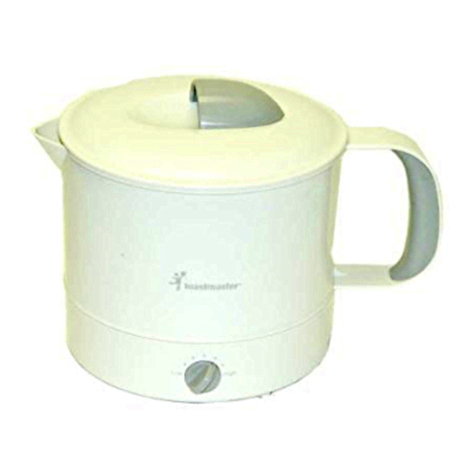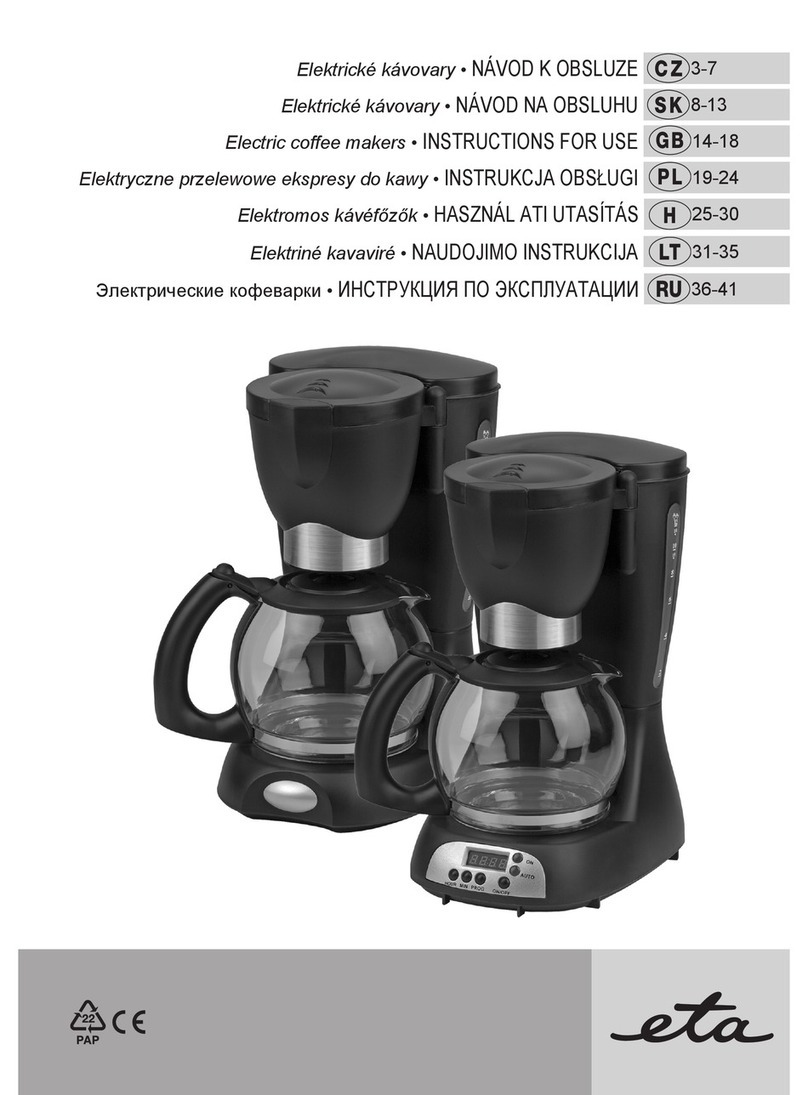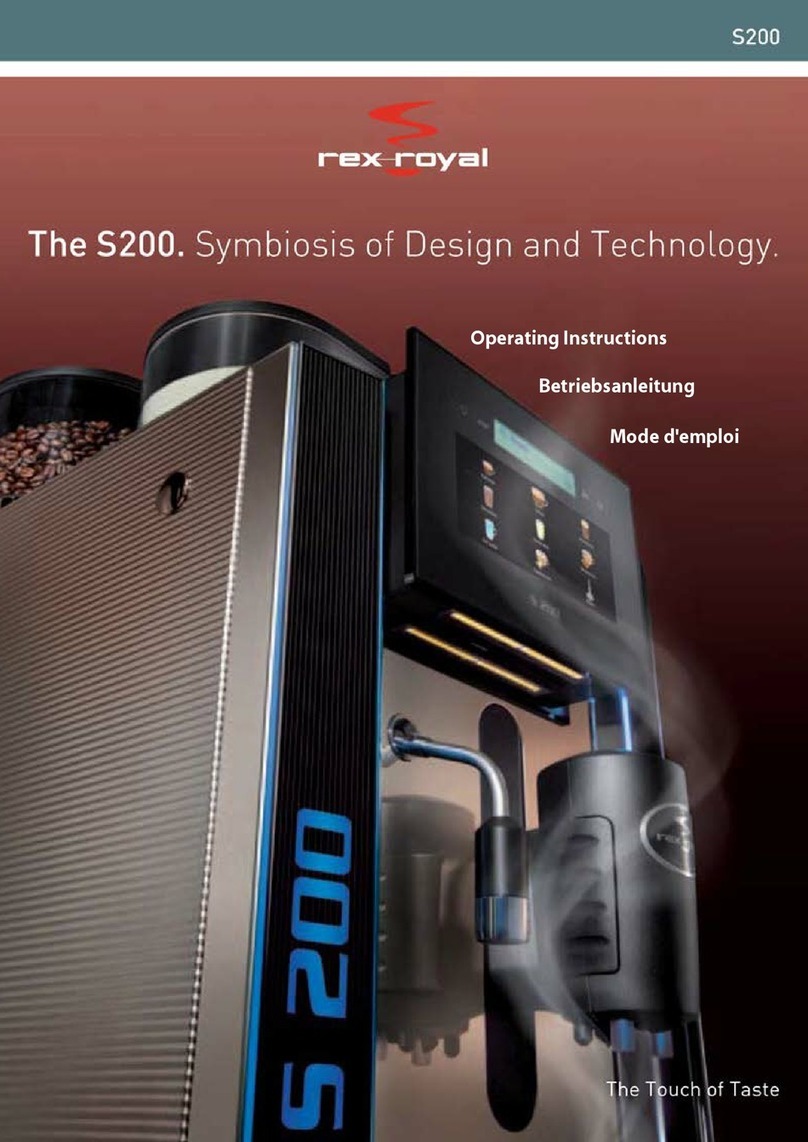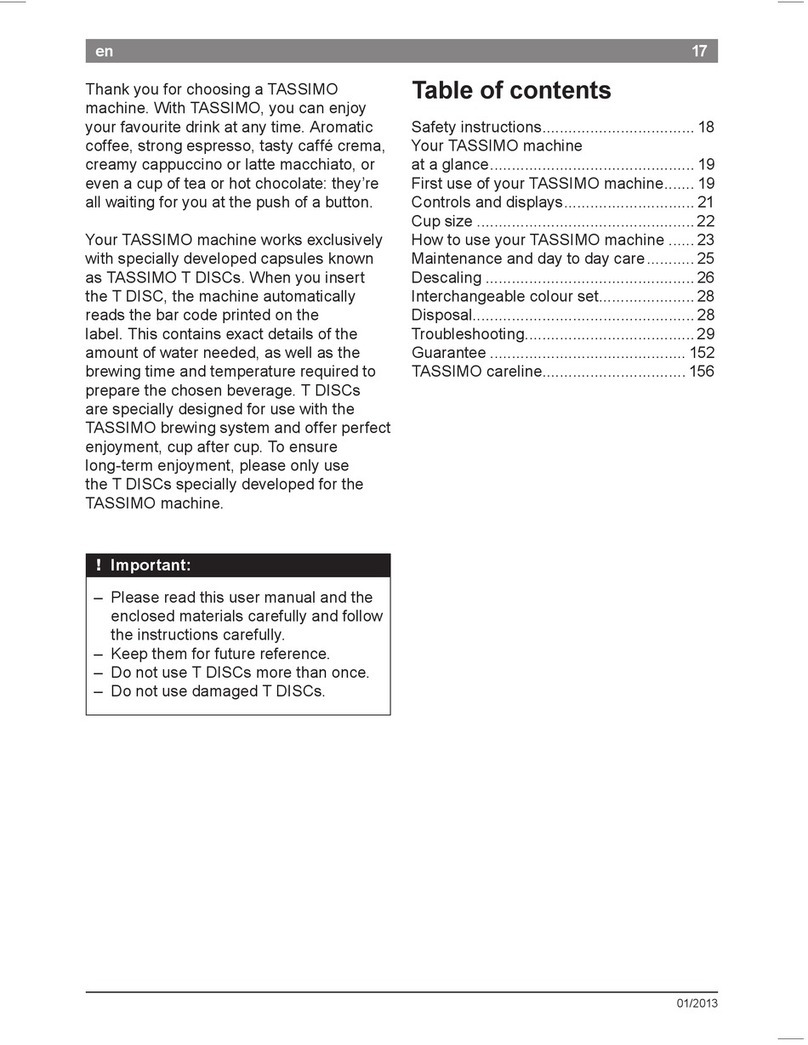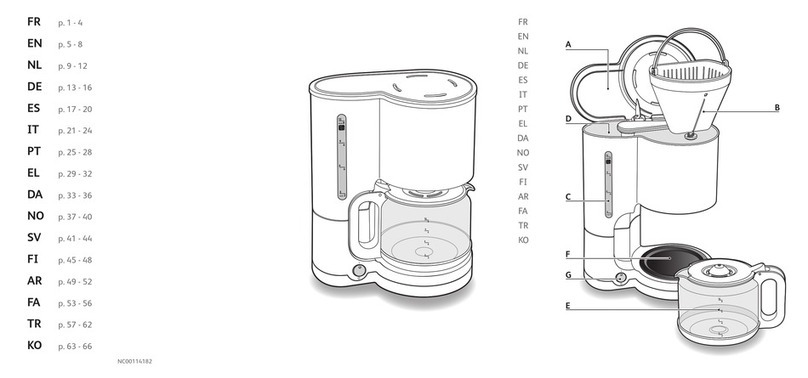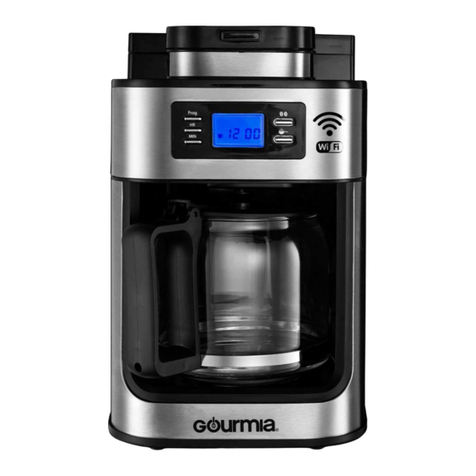Prosyd The iQ User manual

MANUALE USO E MANUTENZIONE
USE AND MAINTENANCE MANUAL
The iQ

DECLARATION OF CONFORMITY
Prosyd Srl
Via Roma,43 - 22077 Olgate Comasco (CO) Italy
states that the range of professional coffee machines model:
THE IQ ES/SOL
is complying with the safety measures foreseen by the directives:
1. Low Voltage Directive EEC 73/23 EEC 93/68 EEC2006/95 - LV -
2. Electromagnetic compatibility EEC 89/336 EEC 91/263 EEC 92/31
93/68 EEC 2004/108 -EMC-
3. MATERIALS AND ARTICLES IN CONTACT WITH FOOD
(1) REG. (EC) 1935/2004 on materials and articles intended to come into contact with food
(2) REG. (EC) 1895/2005 on the restriction of use of certain epoxy derivatives in materials
and articles intended to come into contact with food
(3) DIR. 2002/72 EC relating to plastic materials and articles intended to come into
contact with foodstuffs
The tests have been made in accordance with the Harmonized European Standards
1) LOW VOLTAGE (Electrical safety LV):
EN 60335-1 : 2002 + A1+ A11 (Safety of Household and Similar Electrical Appliances)
EN 60335-2-75: 2004+ A1 (Safety for Vending and dispensing Machines)
EN ISO 11201 + EN ISO 3744 Measurement of acoustic noise
Sound Pressure Level: LpA < 70 dB(A)
2) ELECTROMAGNETIC COMPATIBILITY (EMC)
EN 55014-1:2000+A1+A2
EN 55014-2:1997+A1
EN 61000-3-2: 2000+A2
EN 61000-3-3:1995+A1+A2
EN 61000-4-4
EN 61000-4-5
EN 61000-4-6
EN 61000-4-11
EN 61000-4-2
EN 50366:2003 +A1 Measurement of Electromagnetic field
3) MATERIALS AND ARTICLES IN CONTACT WITH FOOD
D.M. 21-03-1973 and its amendements ⇒D.M. 2006 May 4th nr. 227, and receiptment of
European Directives:82/711/EEC, 85/572/EEC, 93/8/EEC, 97/48/EC, 2002/72/EC, 2004/13/EC,
2004/19/EC, 2005/79/EC, Reg. EC n. 1935/04 e Reg.EC n. 1895/2005.
Olgate Comasco (CO), 2008 SEPTEMBER
CHIEF EXECUTIVE OFFICER
Aviel Dafna

30
SAFETY SYMBOLS
BEFORE USING THE MACHINE, READ THIS MANUAL CAREFULLY FOR ITS CORRECT USE INAC-
CORDANCE WITH THE CURRENT SAFETY STANDARDS.
PICTOGRAMS
IMPORTANT NOTICES
USER
The user is defined as the person authorized to collect drinks from the automatic beverage machine .
The user is not allowed to undertake any maintenance operations either ordinary or extraordinary.
In the event of a fault the user is obliged to notify the maintenance technician or the person responsible
for running the automatic beverage machine .
MAINTENANCE TECHNICIAN
The maintenance technician is defined as being the person responsible for filling up the containers with
soluble products, sugar, coffee, stirrers and cups.
The maintenance technician is also responsible for cleaning the beverage machine (see operations indicated
in chapter 7.0). In the event of a fault the maintenance technician must call the installation technician.
INSTALLATION TECHNICIAN
The installation technician is defined as the person responsible for the installation of the automatic beverage
machine , the starting up operations and the function settings.
Each regulation operation is the exclusive responsibility of the installation technician who also holds the
programming access password.
ATTENTION: Important safety indications
READ the instruction manual machine carefully before using the machine
For any service or maintenance switch off the machine
ATTENTION: machine switched on
ATTENTION: hot parts in contact!

31
1.0 PREMISE
1.1 Important notices
This automatic beverage machine has been designed and con-
structed in full accordance with current safety regulations and is
therefore safe for those who follow the ordinary filling and cleaning
instructions as indicated in this manual.
The user must not under any circumstances remove the
guards that require a tool for removal.
Some maintenance operations (to be done solely by specialized
technicians and indicated in this manual with a special symbol)
require that specific safety protections of the machine must be
switched off .
In accordance with the current safety regulations, certain opera-
tions are the exclusive responsibility of the installation technician,
and the ordinary maintenance technician may have access to
specific operations on with specific authorization.
The acquaintance and absolute respect, from a technical point of
view, of the safety instructions and of the danger notices contained
in this manual, are fundamental for the execution, in conditions
of minimum risk, for the installation, use and maintenance of
this machine.
1.2 General Instructions
Knowledge of the information and instructions contained in the
present manual is essential for a correct use of the automatic
vending machine on the part of the user .
– Interventions by the user on the automatic vending machine
are allowed only if they are of his competence and if he has
been duly trained.
The installation technician must be fully acquainted with all
the mechanisms necessary for the correct operation of the
machine.
– It is the buyer’s responsibility to ascertain that the users have
been trained and are informed and regulations indicated in the
technical documentation supplied.
Despite the full observance of the safety regulations by the
constructor, those who operate on the automatic dispensers
must be fully aware of the potential risks involved in operations
on the machine.
– This manual is an integral part of the equipment and as such
must always remain inside of the same, so as to allow further
consultations on the part of the various operators, until the
dismantlement and/or scrapping of the machine.
– In case of loss or damage of the present manual it is possible
receive a new copy making application to the manufacturer,
with prior indication of the data registered on machines’ serial
number.
– The functional reliability and optimization of machine’s ser-
vices are guaranteed only if original parts are used.
– Modifications to the machine not previously agreed on with
the construction company and undertaken by the installation
technician and/or manager, are considered to be under his
entire responsibility.
INDEX
1.0 PREMISE
1.1 Important notices
1.2 General Instructions
2.0 TECHNICAL CHARACTERISTICS
3.0 DESCRIPTION OF THE MACHINE’S
TECHNICAL CHARACTERISTICS
3.1 Description of the machine
3.2 Scheduled Use
3.3 Models
3.4 Basic instructions for the machine operation
4.0 TRANSPORTING THE AUTOMATIC
VENDING MACHINE
4.1 Moving and Transport
4.2 Stocking
4.3 Packing
4.4 Reception
4.5 Unpacking
5.0 SAFETY RULES
6.0 INSTALLATION
6.1 Positioning
6.2 Water supply connection
6.3 Power supply connection
6.4 Machine starting up
6.5 Installation
6.5.1 Filling of water circuit
6.5.2 Cleaning of parts in contact with food
substances
6.6 Product loading
6.6.1 Product container loading
6.6.2 Payment system installation
7.0 MAINTENANCE AND INACTIVITY
7.1 Cleaning and loading procedures
7.1.1 Procedure for beverage machine cleaning
7.1.2 Periodic cleaning by the maintenance
technician
7.1.3 Daily cleaning recommended
7.1.4 Weekly cleaning procedures
7.1.5 Product Loading instructions
7.2 Recommended maintenance
7.2.1 Ordinary and extraordinary maintenance
7.2.2 Coffee Group maintenance
7.3 Regulations
7.3.1 Dosage and grinding regulation
7.3.2 Instant electrovalve water flow regulation
7.4 When the unit is not working
8.0 DISMANTLEMENT

32
All the operations necessary to maintain the machine’s effi-
ciency, before and during it’s use are at the users charge.
– Any manipulations or modifications made to the machine that
are not previously authorized by the manufacturer, relieve
the latter from any responsibility for damages deriving from,
and will automatically result in the cancellation of the machine
guarantee terms.
– This manual reflects the status at the moment of the emission
of the automatic vending machine on the market; possible mo-
difications, upgrading, adaptments that are done the machine
and that are subsequently commercialized do not oblige the
constructor neither to intervene on the machine previously
supplied, nor, neither to update the relative technical docu-
mentation supplied together with the machine.
– It is however the constructor faculty, when deemed opportune
and for valid motives, to adjourn the manuals already present
on the market, sending to their customers adjournment sheets
that must be kept in the original manual.
Possible technical problems that could occur are easily resolvable
consulting this manual; For further information, contact the beve-
rage machine from whom the machine has been purchased.
IWhen calling it is advisable to be able to give the following in-
formation:
The data registered on the serial number label (Fig.1.1)
The version of the programme contained in the microprocessor
(adhesive label applied to the component the assembled on the
Master board ) (Fig.1.2).
The constructor declines any responsibility for damages caused
to people or belongings in consequence to:
Incorrect installation
Inappropriate electrical and/or water connection.
Inadequate cleaning and maintenance
Not authorized modifications
Improper use of the beverage machine
Not original spare parts
–Under no circumstances is the constructor obliged to compen-
sate for eventual damage resulting from the forced suspension
of drink deliveries as the result of faults.
– Installation and maintenance operations , must be done exclu-
sively by qualified technical personnel with prior training for
carrying out these duties.
–For refilling use only food products that are specific for auto-
matic vending machines.
– The automatic beverage machine is not suitable for external
installation. The machine must be installed in dry places, with
temperatures that never go below 1°C it must not be installed
in places where cleaning is done with water hoses (ex. big
kitchens.).
Do not use water jets to clean the machine.
– If at the moment of the installation, if conditions differing from
those indicated in the present manual, or should the same un-
dergo changes in time, the manufacturer must be immediately
contacted before use of the machine.
– Also check that any other eventual norms or regulations as laid
down by national or local legislation are taken into account and
FIG.1.2
FIG.1.1

33
Fig. 2.1
Height (A) mm 610
Width (B) mm 387
Depth (C) mm 480
Weight kg 32,2
Power Supply V 230 - V 120
Power frequency Hz. 50 - Hz. 60
Installed power (1) From 1,63 to 2,1 kW
AVERAGE CONSUMPTIONS:
Water supply connection 3/4” gas
Electrical supply connec. Schuko plug
WATER SUPPLY
from main supply with pressure between 0.5 and 6.5 bar
BOILER RESISTANCES
of armoured type:
1500 W for espresso boiler version
2000 W for the instant powder boiler version
PRODUCT CONTAINER CAPACITY
Coffee bean container kg 0,8
Instant coffee kg 0,35
Powder milk kg 0,5
Powder milk (Double unit) kg 1,0
Chocolate kg 1,0
Chocolate (Double unit) kg 2,0
Lemon tea kg 1,4
Natural tea kg 0,85
Broth kg 1,2
Sugar kg 1,3
2.0 TECHNICAL CHARACTERISTICS
(1) Check the rated output indicated on the data plate applied by
the beverage machine .

34
Fig. 3.1
Espresso version
3.0 GENERAL TECHNICAL DESCRIPTIONS
3.1 Machine description
Espresso version (Fig. 3.1)
1 Keyboard cards
2 Container units for soluble drinks and sugar
3 Master board
4 Espresso boiler
5 Coffee group and grinder
6 Water supply mains inlet
7 Power supply mains infeed

35
Fig. 3.2
Instant version
3.2 Machine description
Instant version (Fig. 3.2)
1 Keyboard cards
2 Container units for soluble drinks and sugar
3 Master board
4 Instanr bolier
5 Water supply mains inlet
6 Power supply mains infeed

36
SUGAR DISPENSER
Where provided for and where requested, a set, maximum dose
quantity of sugar is dispensed.
For both versions, the sugar is pre-mixed in with the beverage.
The delivery procedure is as follows:
The geared motor operates the sugar container volute, pouring the
required amount inside the powder conveyor (fig.3.4).
3.4 Basic operation concepts
During the normal functioning the beverage machine remains in
standby status.
Introducing the necessary amount, according to the set price,
and after pressing the key relative to the desired drink, the
drink dispensing cycle is activated and can be divided different
processes:
CUP AND SPOON COLLECTION
The “The iQ” automatic beverage machine does not feature an
automatic cup and spoon beverage machine . The user must
therefore procure the same in an independent manner from the
special beverage machines placed at disposal in the vicinity of the
beverage machine , and must undertake to position them correctly
in the delivery compartment (fig. 3.3).
The presence and/or dimension of the cup can be automatically
detected by the beverage machine (optional feature) by way of 3
photo-sensors lodged into the cup compartment.
In general, the acknowledgement of the size of the cup is based
on the following principle outlines:
#
#
#
#
#
#
Bevanda standard
o regular
Bevanda lunga
o long
Bevanda molto lunga
o extra-long
Fig. 3.3
Fig. 3.4
3.3 Foreseen use
The beverage machine is exclusively for the dispensing of drinks,
prepared mixing food substances with water (by infusion as far
as concerns coffee).
For this purpose use products declared as suitable by the manu-
facturer for automatic distribution in open containers.
The plastic cups and the stirrers for sugar mixing will be placed at
the disposal of the user as they are not automatically dispensed
by the “The iQ” beverage machine.
The drinks must be consumed immediately and in no case are to
be kept for subsequent consumption.

37
Fig. 3.6
Fig. 3.5
INSTANT DRINKS
According to the type drink requested and to the beverage machi-
ne model, several of the various processes described here below
can be activated.
– The solenoid valve fixed to the instant boiler is engaged in
order to deliver the required quantity of water into the mixer
(fig.3.5).
– The pump that delivers the required amount of water is activa-
ted; and controlled by a special electronic device (volumetric
counter), which withdraws from the instant boiler.
– The instant product geared motor activates the helicoidal screw
conveyor so as to dispense the quantity of product programmed
into the mixer (in some versions more than one product can
be conveyed into the same mixer) (Fig.3.6)
– once the preset quantity of water and powder is dispensed, the
whipper motor is switched off.

38
Fig. 3.7
Fig. 3.9
Fig. 3.8
Fig. 3.10
ESPRESSO COFFEE
This process functions only the models equipped with the coffee
espresso group, after the cup and sugar dispensing processes
have been effected.
– the grinder is activated until it reaches the dose of ground coffee
set by the doser (Fig.3.7)
– the doser electromagnet is activated , causing the opening of the
door and consequent fall of the coffee into the brew chamber
– the rotation group geared motor brings it into the dispensing
position and simultaneously compresses the ground coffee
(Fig.3.8).
– the pump that dispenses the quantity of programmed water and
that is controlled by a specific electronic device, (volume meter),
withdrawing the water from the coffee boiler (Fig.3.9).
– the coffee group geared motor is activated again so as to bring
again into standby position; during this movement the used
coffee grounds are expelled (Fig.3.10).
The operational sequence (coffee grinding and release) may
occur in an inverse order according to the type of programming
involved.

39
4.0 MOVING AN AUTOMATIC VENDING
MACHINE
4.1 Moving and transport (Fig.4.1)
The beverage machine must be shifted by 2 people (Fig.4.1).
Avoid :
– lifting the beverage machine with ropes or presses
– dragging the beverage machine
– upset or lay down the beverage machine during transport
– give jolts to the beverage machine
Prevent the beverage machine from:
– being knocked
– Stacking other objects on it
– Being exposed to the elements
– Positioned in damp places
The construction company is not liable for any damage which
may be caused for the partial or complete non-observance of the
warning notices indicated above.
4.2 stocking
For eventual stocking, avoid laying several machines over each
other, maintain it in vertical position, in dry places with tempera-
tures not inferior to 1°C.
4.3 Packing
The beverage machine is supplied in a cardboard box protected
by polystyrene packaging (Fig.4.2).
The automatic beverage machine will be delivered packed, assuring
both a mechanical protection and protection against damages
from the external environment.
On the package labels are applied indicating:
maneouver with care
don’t turn upside-down
protect from the rain
don’t superimpose
protect from sources of heat
not resistant against bumps
type of beverage machine and serial number.
4.4 Reception
Upon reception of the automatic beverage machine you need to
check that the same has not suffered damages during the tran-
sport.
If damages of any nature are noticed place a claim with the
forwarder immediately.
At the end of the transport the packing must result
without damages which means it must not :
– present dents, signs of bumps, deformations or damages of the
external packaging
– present wet zones or signs that could lead to suppose that the
packing has been exposed to rain, cold or heat.
– present signs of tampering
4.5 Unpacking
Remove the beverage machine from its packaging, lifting the
polysterene panels and removing it from the box (Fig.4.2).
Fig. 4.1
Fig. 4.2
kg 32,2

40
– remove the key from the drink dispensing chamber (Fig.4.3)
In some versions the key is not provided because the beverage
machine is equipped with a magnetic closing option.
– open the door of the beverage machine and remove the adhesive
tape from the components listed here below:
coin box
coin mechanism cover / keyboard cards
product containers
The packing material must not be left accessible to
others, as it is a potential environmental pollution
sources. For the disposal contact qualified companies
authorized.
Fig. 4.3

41
6.0 INSTALLATION
6.1 Positioning
– As already specified in paragraph 5.0, “Safety norms”, the
beverage machine is not suitable for external installation. The
machine must be connect in dry places, with temperatures that
never go below 1°C it must not be installed in places where
cleaning is done with water hoses(ex. big kitchens.) . It must
be installed in places without danger of explosions or fires.
– If positioned near to a wall, there must be a minimum distance
from the wall of at least 5 cm. (Fig.6.1) so as to allow a regular
ventilation. In no case cover the beverage machine with cloths
or similar.
WARNING! Do not position the device near inflammable
objects, keep a minimum safety distance of 30 cm.
Bianchi Vending S.p.A. declines all responsibility for incon-
veniences due to the non observance of the above mentioned
installation norms.
If the installation is made in safety evacuation corridors make
sure that with the beverage machine door open there is anyhow
sufficient space to pass by (Fig.6.1).
So as to avoid that the floor gets dirty, due to accidental spilling
of the products, use, if necessary, under the beverage machine,
a protection sufficiently wide to cover the beverage machine s’
operating space.
6.2 Connection to the main water supply
Before proceeding with the connection of the beverage machine to
the water main supply verify the following water characteristics:
– that it is drinkable (eventually through an laboratory’s analysis
certification)
– it has a pressure comprised between 0.5 and 6.5 bar ( if this
should not be the case, use a pump or a water pressure, reducer
according to the case).
Fig. 6.1
5.0 SAFETY NORMS
ATTENTION!
– before using the automatic beverage machine , read this manual
carefully.
– The installation and maintenance operations must be performed
exclusively by qualified technical personnel.
– The user must not in any circumstance be able accede to those
parts of the automatic beverage machine that are protected and
require a tool in order to be accessible.
– The knowledge and the absolute respect, from a technical point
of view of the safety instructions and of the danger notices con-
tained in this manual, constitute the basis for the operation ,
in conditions of minimum risk, of the installation, starting and
maintenance of the machine.
Always disconnect the POWER CABLE before
maintenance or cleaning interventions.
ABSOLUTELY DO NOT INTERVENE ON THE MACHINE
AND DO NOT REMOVE ANY PROTECTION BEFORE THE
COOLING OF THE HOT PARTS!
– The functional reliability and optimization of machine’s ser-
vices are guaranteed only if original parts are used.
– The beverage machine is not suitable for external instal-
lation. The machine must be connect in dry places, with
temperatures that never go below 1°C it must not be in-
stalled in places where cleaning is done with water hoses
(ex. big kitchens). Do not use water jets to clean the
machine.
– In order to guarantee normal operation, the machine must be
installed in areas that the environmental temperature is between
a minimum of -1°C and a maximum of +32°C end humidity of
not over 70%.
– In order to guarantee a regular operation, always maintain the
automatic beverage machine in perfect cleaning conditions
– Bianchi Vending S.p.A. declines all responsibility for damages
product to people or belongings in consequence to:
Incorrect installation
Inappropriate electrical and/or water connection.
Inadequate cleaning and maintenance
Not authorized modifications
Improper use of the beverage machine
Not original spare parts
– Futhermore verify observance of any other eventual local and
national standards.

42
6.3 Main Power supply connection
The beverage machine is suitable for operation at single-phase
voltage of 230 volt and is protected by 2 12.5 A fuses and by a
10A fuse on the MASTER card.
We suggest to check that:
– the tension of net of 230 V doesn’t have a difference of more
than ± 10%
– The power supply output is able to bear the power load of the
machine.
– use a system of diversified protection
– position the machine in such a way as to ensure that the plug
remains accessible
The machine must be connected to earth in observance with the
current safety norms.
For this reason, verify the plant’s earth wire connection to ascertain
that it is efficient and it answers national and European safety
electric standards. If necessary require the intervention qualified
personnel for the verification of the plant.
– The beverage machine is equipped with a power supply cable
of H05VV-F 3x1 mm², with SCHUKO plug (Fig.6.6).
– The sockets that are not compatible with that of the machine
must be replaced. (Fig.6.7).
– The use of extension, adapters and/ or multiple plugs is forbid-
den. Bianchi Vending S.p.A. declines all responsibility for
damages deriving for the complete or partial failure to
observe these warnings.
Should the power cable be found to be damaged, immediately
disconnect from the power socket.
The power supply cables are to be replaced by skilled per-
sonnel.
Fig. 6.6 Fig. 6.7
Fig. 6.2 Fig. 6.3
Fig. 6.5
OK
Fig. 6.4
– install, if not present, a tap in an accessible position to isolate
the machine from the water mains should it be found to be
necessary (Fig.6.2).
– before making water connections, make some water flow out
of the tap so as to eliminate possible traces of impurities and
dirt (Fig.6.3)
– connect the cock to the beverage machine, using a pipe in nylon
material suitable for food products and suitable for the mains
pressure. In the event of the use of a flexible pipe it is necessary
to fit the reinforcement bush supplied inside (Fig. 6.4).
– the foreseen connection is a 3/ 8 gas (Fig.6.5).

43
Fig. 6.8
Fig. 6.10
Fig. 6.9
6.4 Starting up of the unit
The beverage machine is provided with a connection cable for
connection to the mains water supply (fig.6.8) and a switch whi-
ch cuts off the power from all users each time that it is operated
(fig.6.9).
Should it be necessary to operate inside the beverage machine
for any ordinary or special maintenance operates, it is necessary
to isolate the user appliances by activating the switch (fig.6.10),
bearing in mind that with the electrical connection engaged, the
power terminals are live.
Each time the beverage machine is switched on a diagnosis cycle
is performed in order to verify the position of the mobile parts and
the presence of water and of some products.

44
6.5 Installation
6.5.1 Boiler fill-ups
The standard boiler fill-up function is provided with a 25 second
timeout setting, within which the level detection sensors must
detect the presence of water.
If this is not the case, the “LACK WATER - CALL SERVICE” message
comes up on display and the beverage machine will therefore not
work for beverage supplies.
It is however possible to start an extended, boiler fill up procedure,
in all cases in which total boiler fill-up is required, for instance at
first machine installation, or after the boiler has been emptied out
for moving and transporting of the beverage machine.
In order to start said first-time boiler fill-up procedure, it is neces-
sary to press the “STOP DISPENSING” key located on the beverage
machine’s keypad within the first 2 seconds after having started
the machine up and to hold it pressed in for 3 seconds.
In this case, the boiler fill-up procedure must complete itself within
4 minutes. Should the boiler not fill-up within a 4 minute time-
out, the beverage machine will keep trying for 3 hours with water
entry electro valve switch-on and switch-off cycles respectively of
4 and 6 minutes each, in order to avoid overheating of the electro
valve winding.
– at the end of the water filling (Fig.6.12), effect a cleaning cycle
of the mixer group so as to fill all the circuits and remove even-
tual residues from the boiler.
In the beverage machine’s installation phase, ascertain,
before switching it on, that the same is connected to the
water supply and that the water faucet is open.
Fig. 6.12
Fig. 6.11
STOP

45
Fig.6.16
6.5.2 Cleaning of the parts in contact with food substances
With beverage machine switched on effect a cleaning of the mixers
pressing the buttons according to what is described in the service
functions so as to eliminate any dirt from the coffee boiler and
the instant boiler.
– wash your hands carefully
– prepare an anti-bacterial cleaning solution with a chlorine base
(products that can be purchased in pharmacies) following the
concentrations given on the product instruction labels.
Before removing the container lower the flap in order to
prevent the accidental escape of the soluble product inside
the same (fig. 6.13).
– Lift the beverage machine’s top shutter door (fig. 6.14).
– remove all the product containers from the beverage machine
(fig. 6.15).
– remove the lids from the product containers covers and product
chutes (Fig.6.16). Dip all in the solution previously prepared
Fig. 6.13
Fig. 6.14
Fig. 6.15

46
Fig. 6.17
Fig. 6.18
Fig. 6.19
– remove all the powder chutes, water funnels, mixing bowls
and whippers and silicone tubes and dip these parts also in
the prepared solution (Fig.6.17)
– with a cloth soaked with the solution clean the whipper assembly
base (Fig.6.18)
– the parts must soak in the solution for the time indicated on
the solutions’ instruction label.
– Recover all the parts, rinse them abundantly, dry them perfectly
and proceed with the re-assembly in the beverage machine.
After re-positioning the container undertake to raise the
flap in order to reset the correct function (fig. 6.19).
For further safety after the assembly of the parts, effect
some automatic cleaning cycles so as to eliminate any
eventual residues.

47
Fig. 6.22 Fig. 6.23
Fig. 6.21
Fig. 6.20
6.6.2 Payment system installation
The beverage machine does not have a payment system; any
possible damages to the beverage machine itself and/or objects
and/or people deriving from its incorrect installation are respon-
sibility of who installs the payment system.
The switches are to be directly connected to the keyboard card,
the executive serial systems require the RS232 payment system
kit supplied separately.
Then go into programming for the correct settings.
Consult manual ”Software instructions” so as to verify setting of
the parameters, that must be coherent with the system used.
6.6 Product container loading
(with machine off)
6.6.1 Loading containers
Filling is possible keeping the containers inserted, and by raising
the upper flap of the beverage machine (Fig. 6.20) or by extrac-
ting each container.
For granulated coffee in particular it is necessary to close the
closure plat before extracting the container.(Fig.6.21).
– remove the covers of each container and load the product accor-
ding to the product indicated on the label (Fig.6.22-Fig.6.23).
– pay attention that they there are no clots, avoid pressing the
product and using an excessive quantity, so as to avoid its
aging in relation to the consumption forseen in the time period
between two loadings.
Check the container product capacity in the section TECHNICAL
CHARACTERISTICS.
This manual suits for next models
1
Table of contents
Popular Coffee Maker manuals by other brands

AEG Electrolux
AEG Electrolux CaFamosa operating instructions
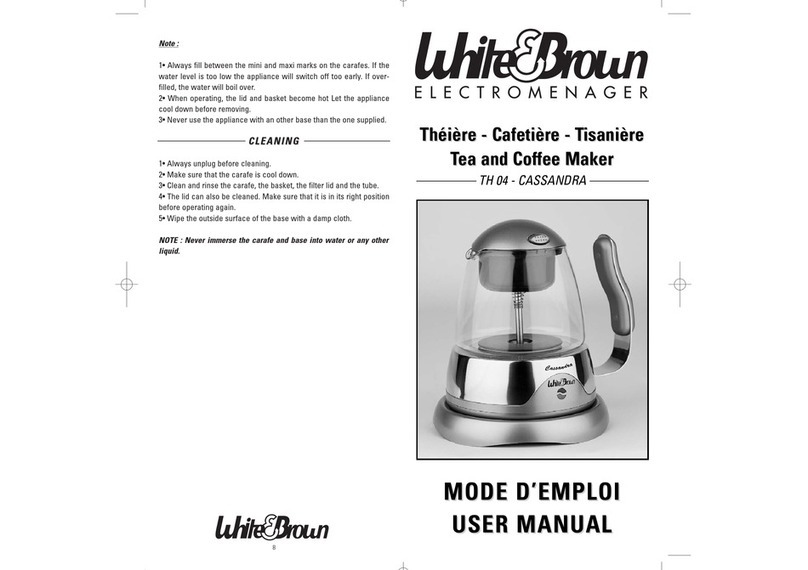
White and Brown
White and Brown TH 04-CASSANDRA user manual
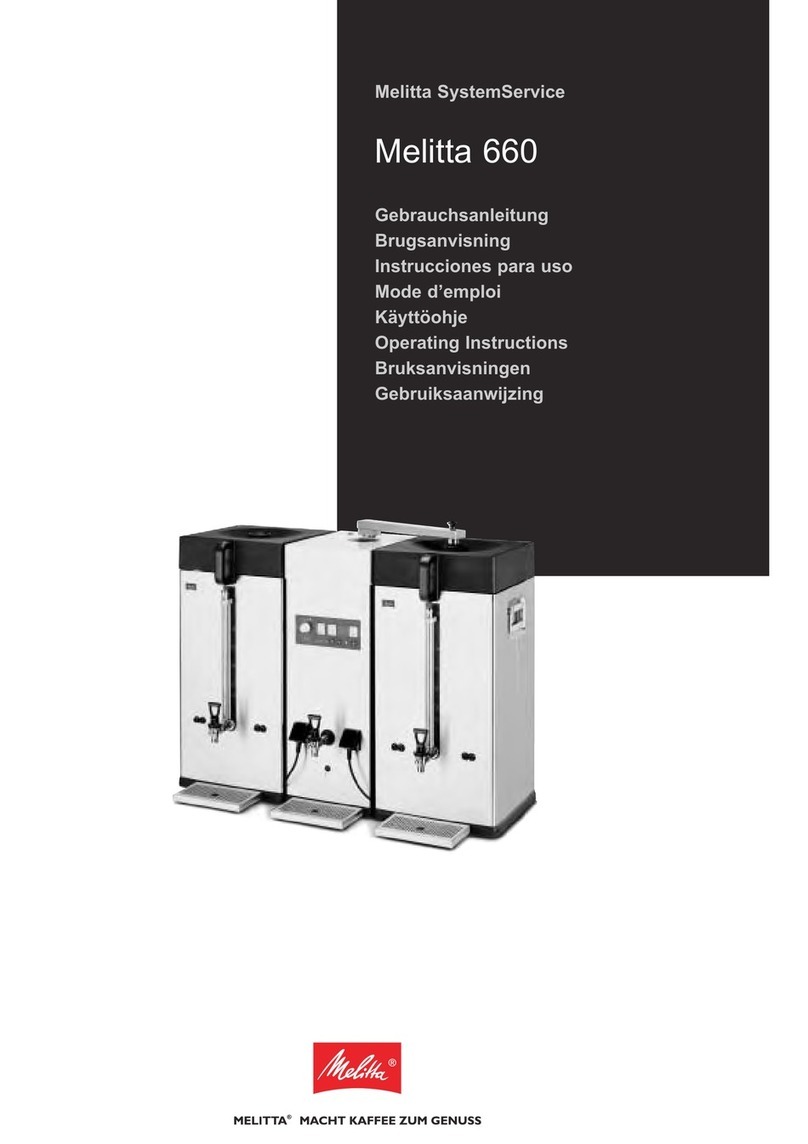
Melitta
Melitta 660 operating instructions

Black & Decker
Black & Decker DCM600B Use and care book
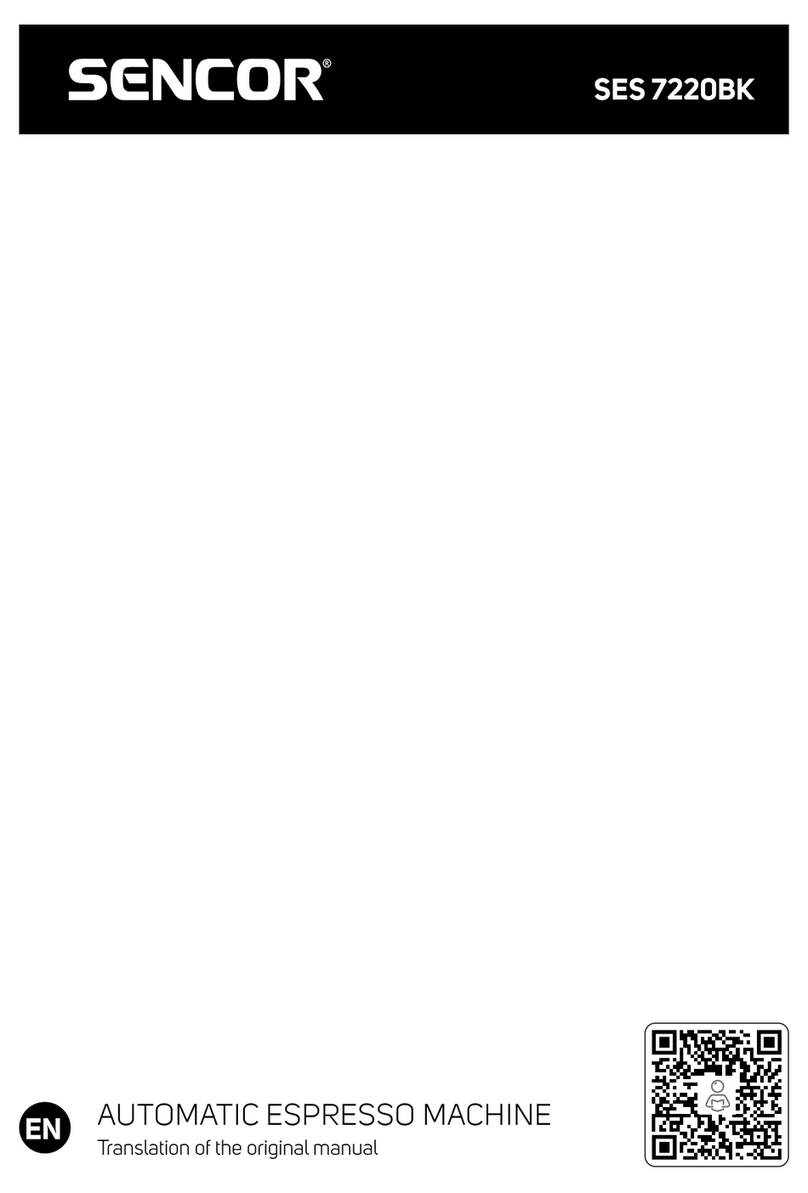
Sencor
Sencor SES 7220BK Translation of the original manual
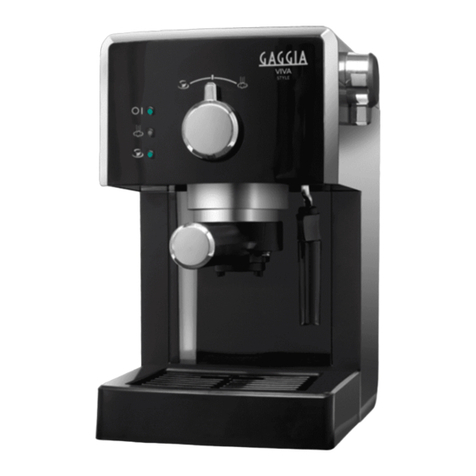
Gaggia
Gaggia VIVA STYLE CHIC operating instructions
